Back in the days when the great city of Uxmal was a power stronghold in the Mayan world people in its streets must have walked proud and tall.
Wow, look at our squares, look at our palaces, look at our pyramids. Man, we rock!
They must have thought their kingdom would rule forever.
Royalty may not live here anymore and the stucco may have faded away, but Uxmal -a UNESCO World Heritage Site- is still around and will be for decades, commanding attention and curiosity.
What makes Uxmal my favourite Mayan ruins in Yucatán, Mexico?
The architectural details are a dream. I fell in love with the intricate geometrical patterns carved in stone. The building ornamentation, with elaborate masks projecting from the corners and animal representations everywhere, is the visual definition of the Puuc style.
As an added bonus, being inland in the Yucatán Peninsula and farther away from the busy spots of Cancún and Playa del Carmen, makes it a way less crowded site than Chichen Itzá and a great day trip from Merida.
Disclosure: This post contains some affiliate links. If you make a purchase through those links I will earn a commission at no additional cost to you (zero, nada). To check the full disclaimer, click here.
These are the highlights of the Mayan archaeological site of Uxmal.
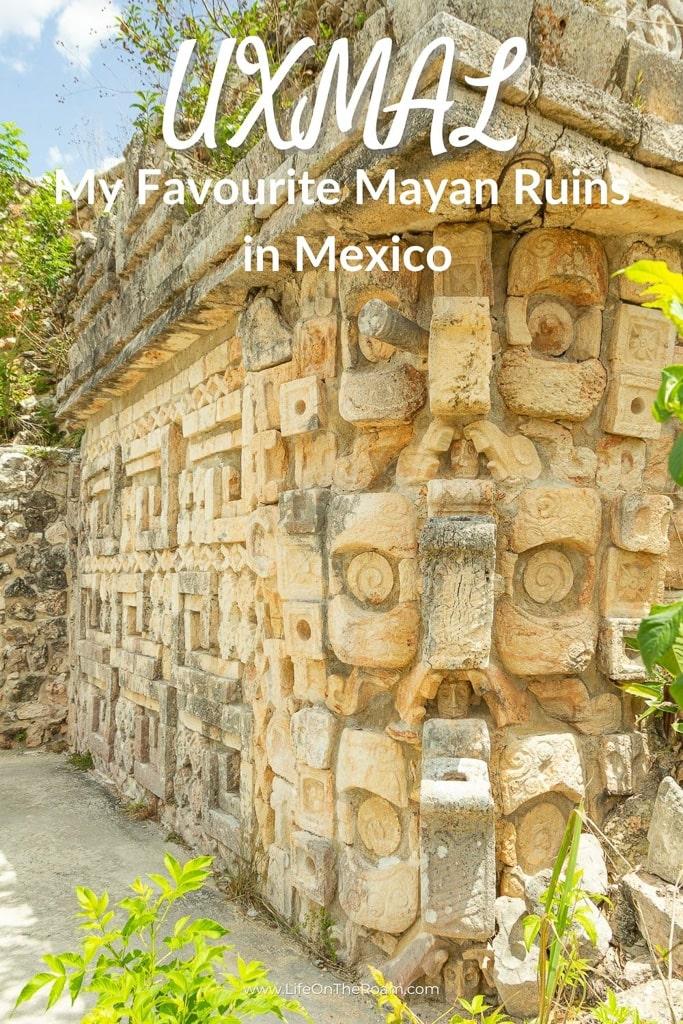
Table of Contents
A Brief History of Uxmal
People started roaming the area around 500 B.C., coming and going. The establishment of the city began around 700 A.D., becoming home for anything between 15,000 and 25,000 souls before its decline.
Between the 9th and the 11th century, during the Classic Maya period, Uxmal (pronounced Oosh-MAHL) was the place from where the most powerful people in the Puuc region would tell the rest what to do.
Agriculture was an important activity, but water was scarce.
With the sky as the only source of water, they built underground cisterns called chultunes that resembled a huge 35,000-litre pitcher to collect whatever rain they would get between late May and November.
Then droughts came, making life harder. This, along with deforestation, is listed as one of the possible downfalls of Uxmal.
The Pyramid of the Magician (Pirámide del Adivino)
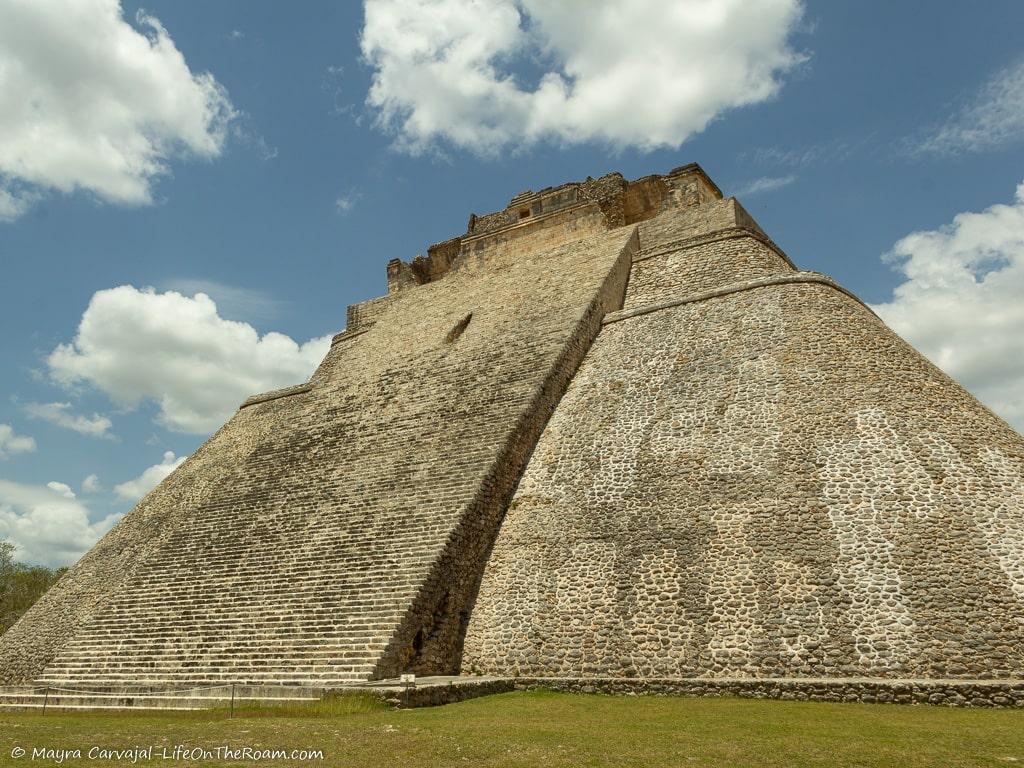
It’s the first thing you see and the perfect start of your walk through the archaeological site of Uxmal.
The imposing 35-metre high pyramid (a bit higher than El Castillo, in Chichen Itzá), built throughout five different periods over previous structures, is unique in the sense that it has rounded edges instead of the typical straight edges. You can see this only in a handful of structures in Yucatán, such as the Oval Palace in Ek Balam.
See the tiny puny doorway around two-thirds up? It reminds me of the little entrance to the mouse house in the baseboard of houses in old cartoons, Tom & Jerry style.
Instead of a mouse, a ruler or a priest (or soothsayer, to use the official term) would pop up from his Puuc-style temple to impress everybody with their knowledge about the moon and stars (the specific function of the pyramid remains a mystery).
The west side entrance, located on the other side, is much more elaborated, with a Chenes-style staircase. Whenever whoever came out of there, it looked like he was emerging from the jaws of monster earth, surrounded by all sorts of diamond-shaped patterns.
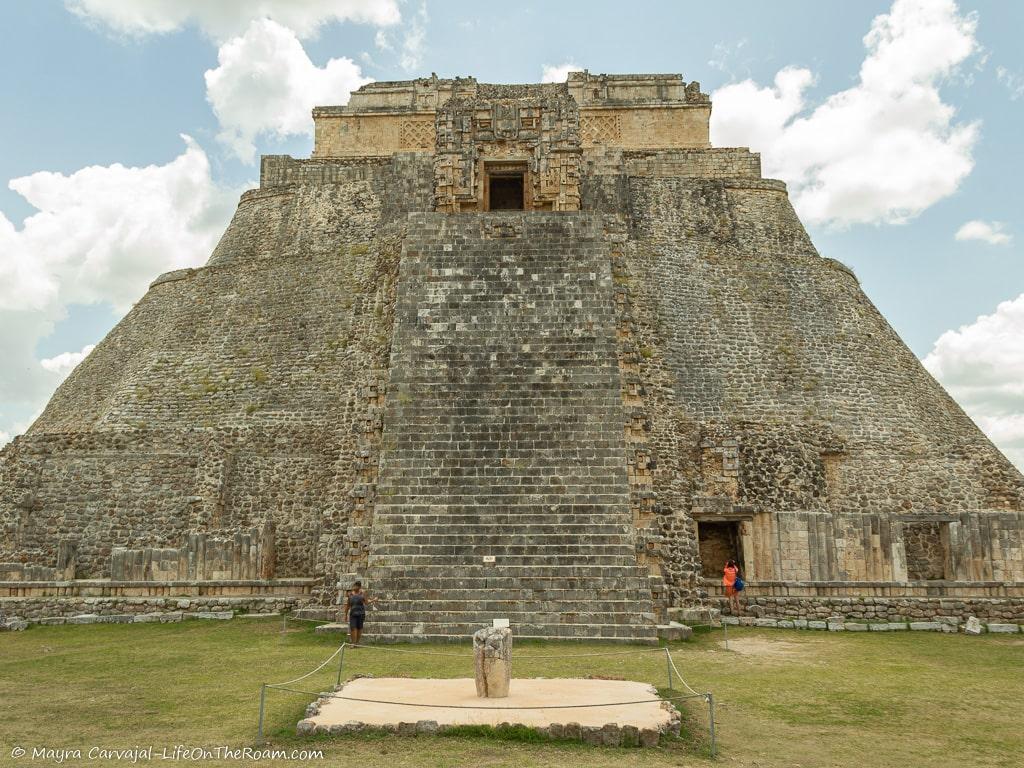
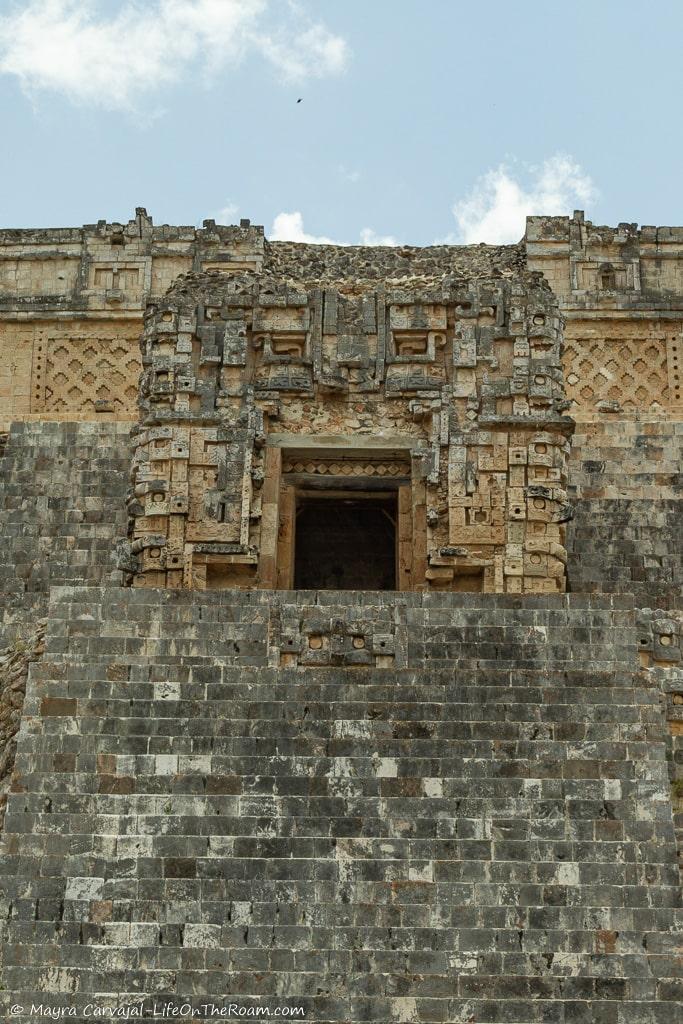
The masks you see flanking the steps to climb this side of the building (nope, you can’t climb this pyramid) represent Chaac, the god of rain. There are 12 on each side, possibly referring to the 24 hours of the day.
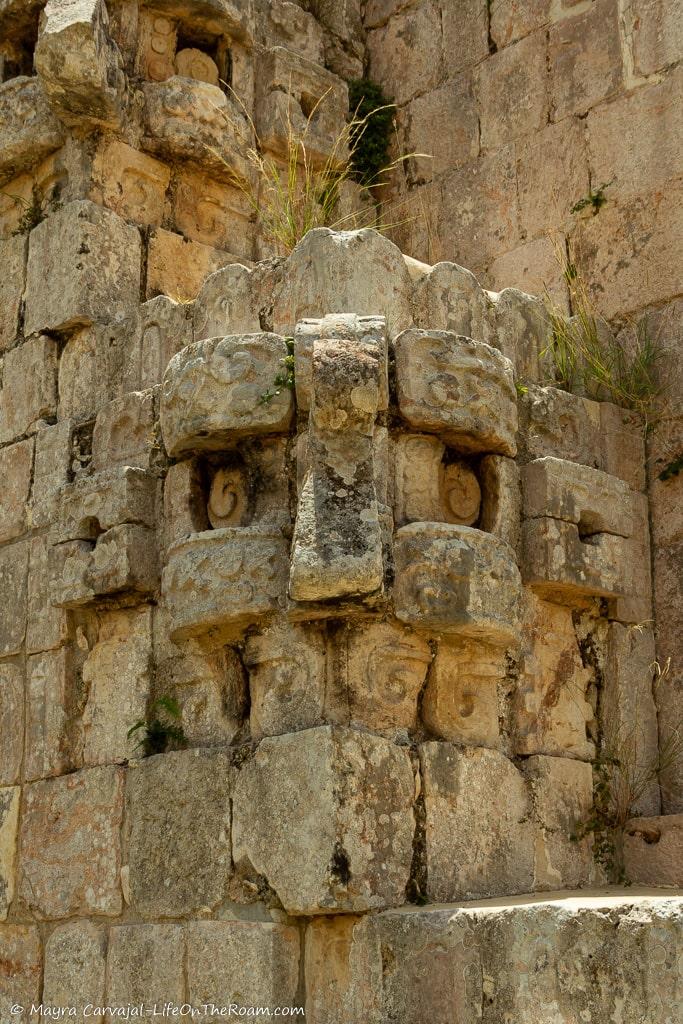
The pyramid is also known as The House of the Dwarf. Forget about the five periods archaeologists say it took to build it. According to a legend, a magical dwarf accepted a challenge from the king to prove that he was what he said he was.
Sure, I can build a massive pyramid overnight. Watch me!
And poof! The next day, there was the pyramid.
The Quadrangle of the Birds (El Cuadrángulo de los Pájaros)
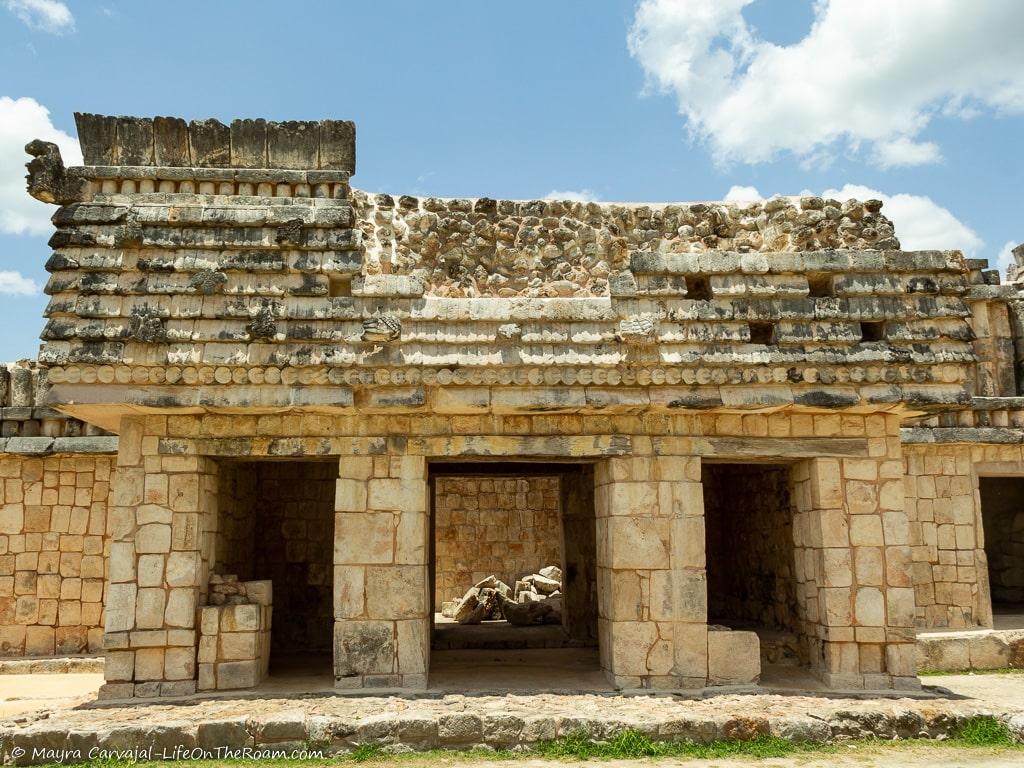
This is one of the most important structures (built between the 8th and the 11th century) formed by four palaces grouped around a central patio with an altar in the middle. From here, one of the very last chiefs of Uxmal gave his last orders. His abode was located on the north building.
On the east side lies the Pyramid of the Magician.
On the west, you’ll see, as expected, sculptures of birds (these are macaws, a symbol of kinkinich kakmo, god of the sun) adorning the upper section of a façade with shapes and carvings that evoke the thatch roofs of Mayan huts. The circles at the bottom symbolize corn.
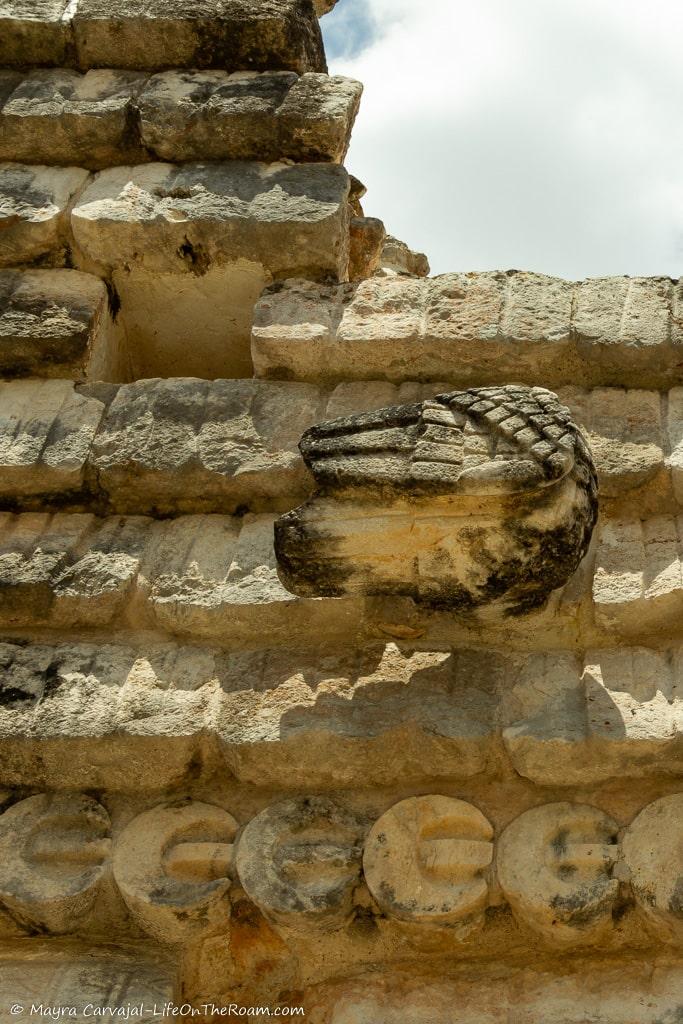
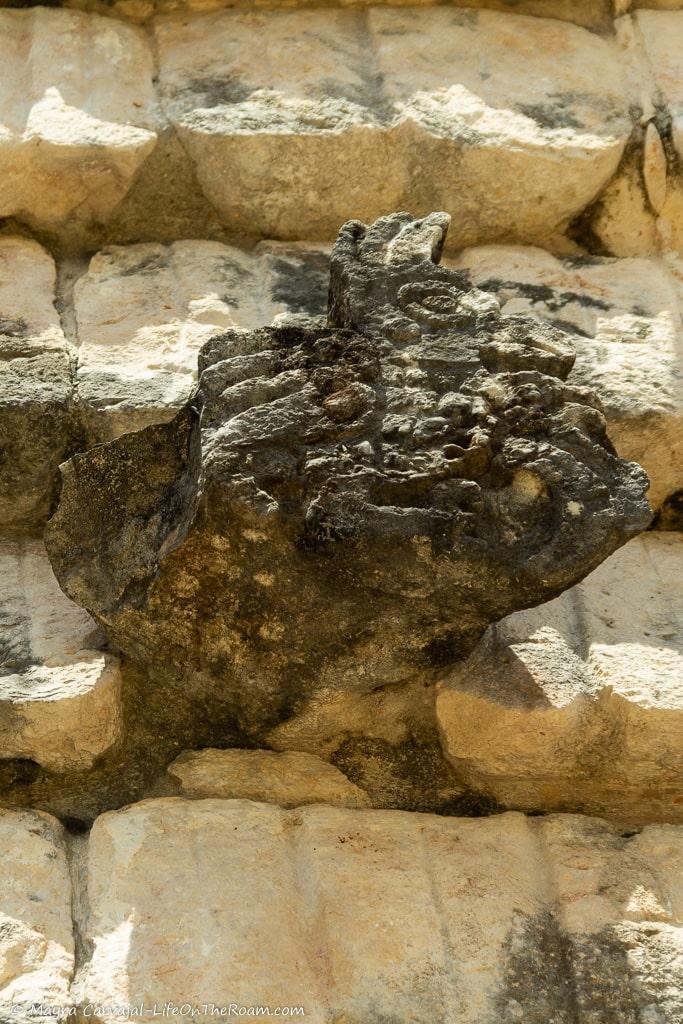
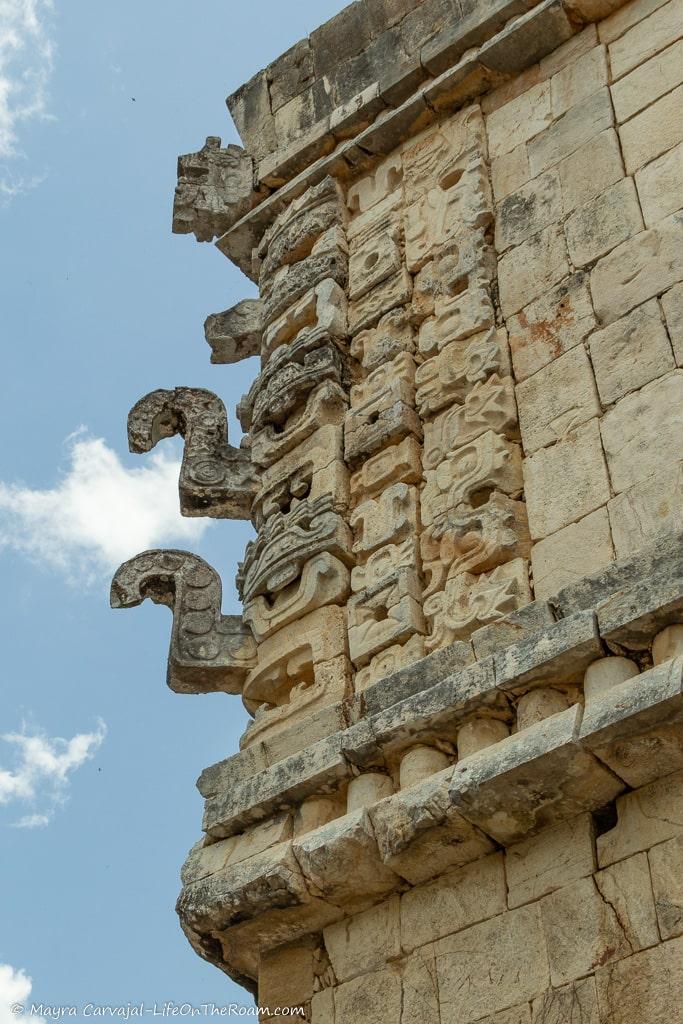
Geometrical patterns and colonnades abound and complement a decoration that matches what you see on the west side of the Pyramid of the Magician.
The Quadrangle of the Nuns (El Cuadrángulo de las Monjas)
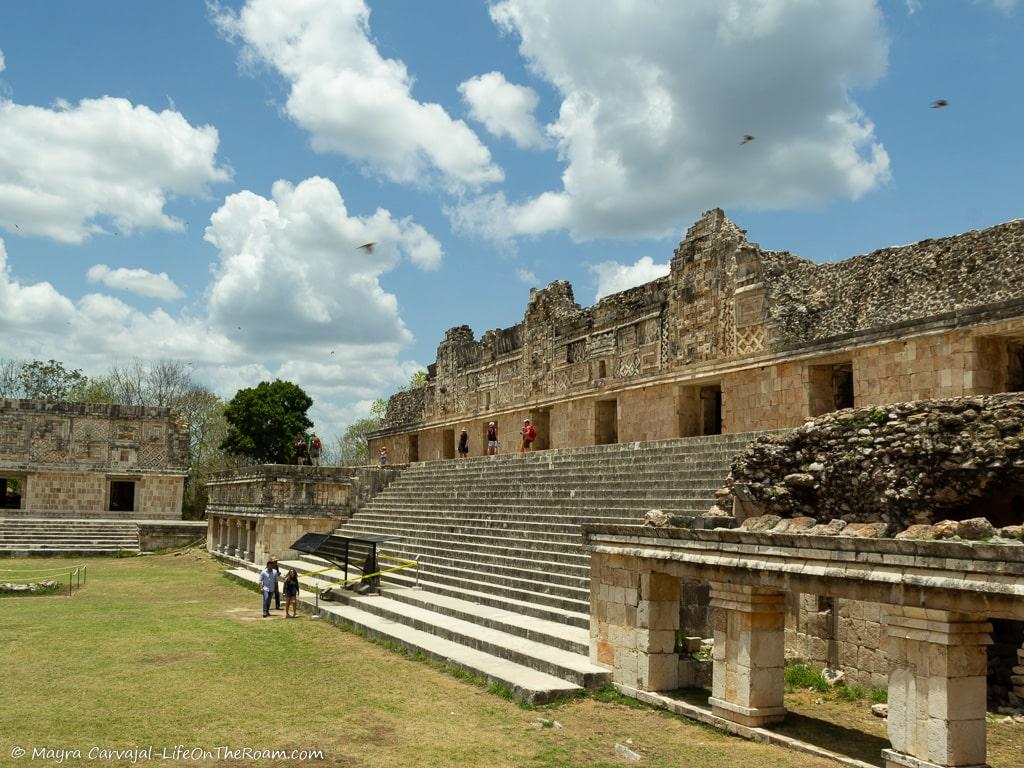
Four buildings facing each other around a courtyard let you admire in one glance the beauty of these former palaces built between 900 A.D.-1000 A.D.
There were no nuns here but a Spaniard who arrived in the 16th century gave it that name because it reminded him of the convents in Spain.
This is my favourite compound in Uxmal. Walk closer to the west building and take your time to see the rich details on top of the panel of frets (representing flowers): two-headed serpents with feathered tails – a reference to Kukulcan, the serpent god- run the entire length of the façade with human heads emerging of the jaws, and Mayan huts crowned with masks of Tlaloc, the god of rain in central Mexico.
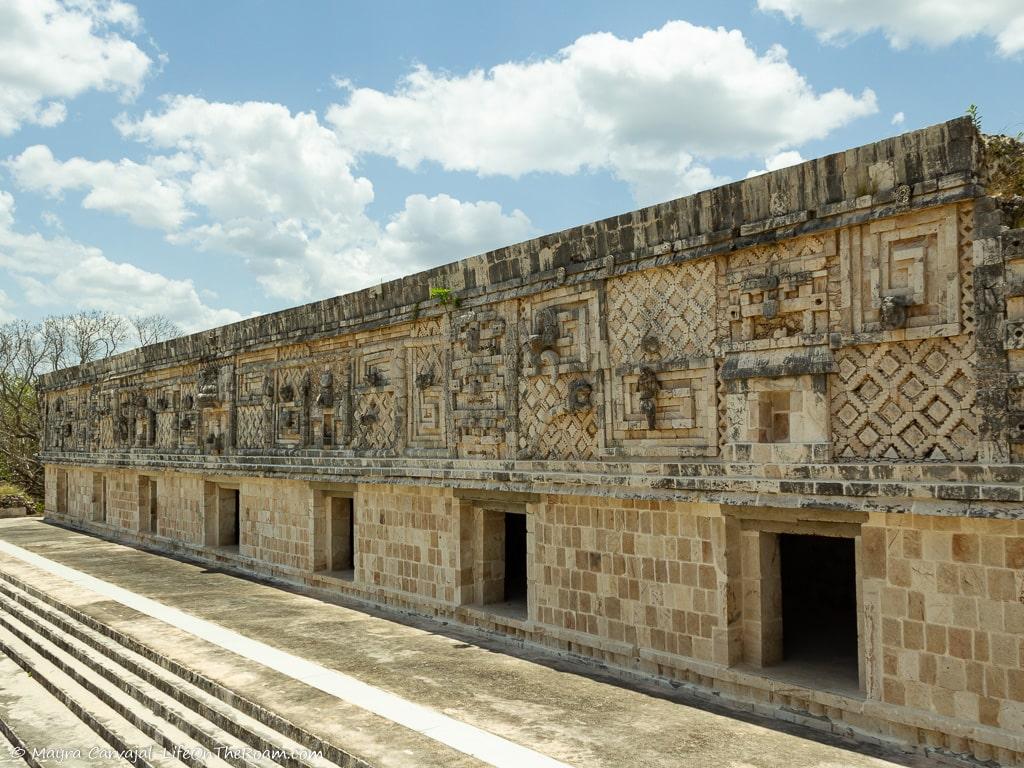
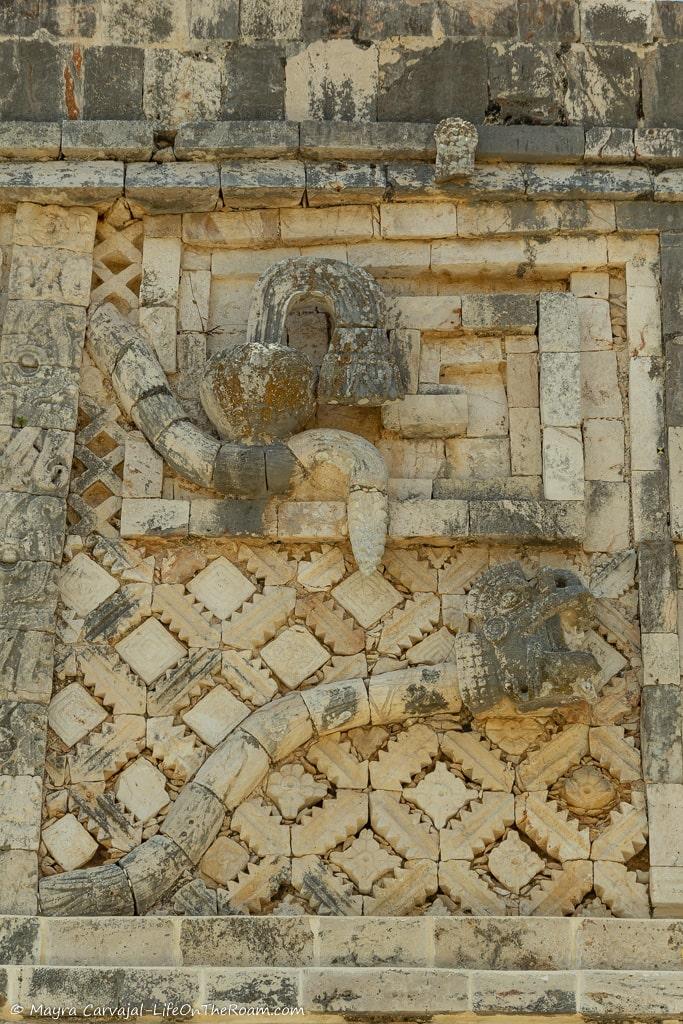
You’ll also find human figures and masks of Chaac on the North building (which they think had a higher hierarchy), with an adorned chapel on its west side.
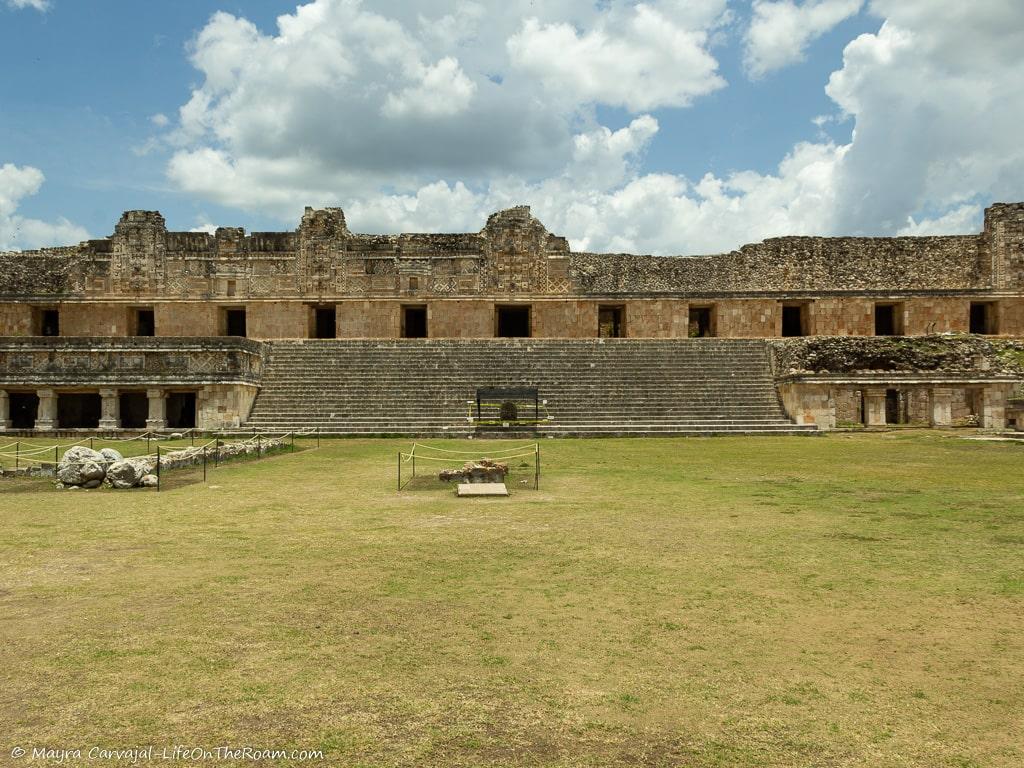
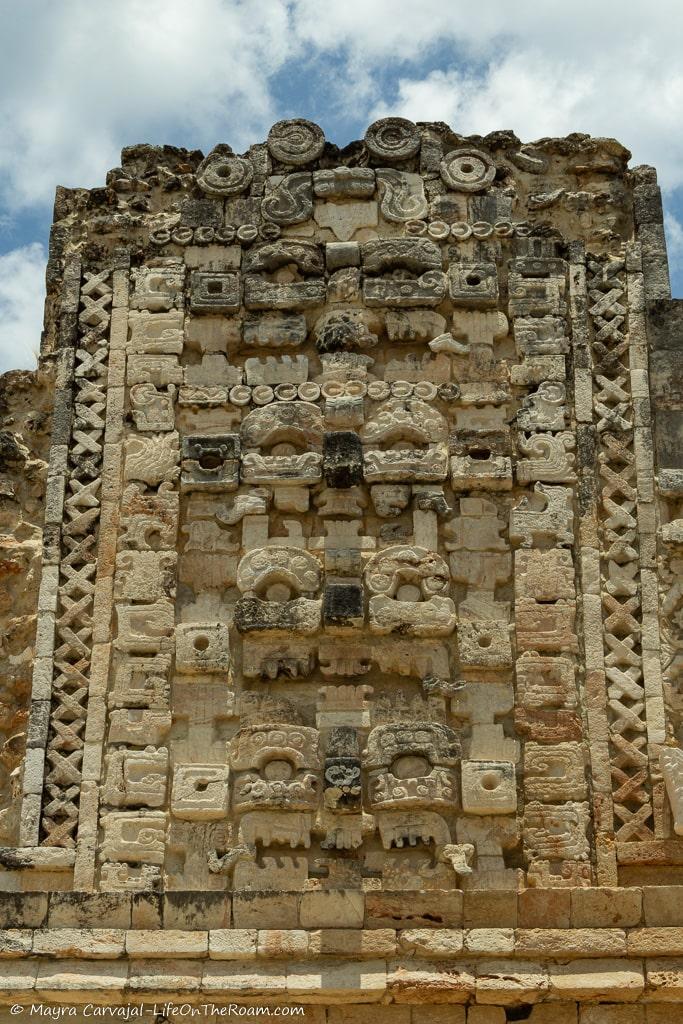
The latticework on the east building represents serpent’s scales.
The Ball Game Court (El Juego de Pelota)
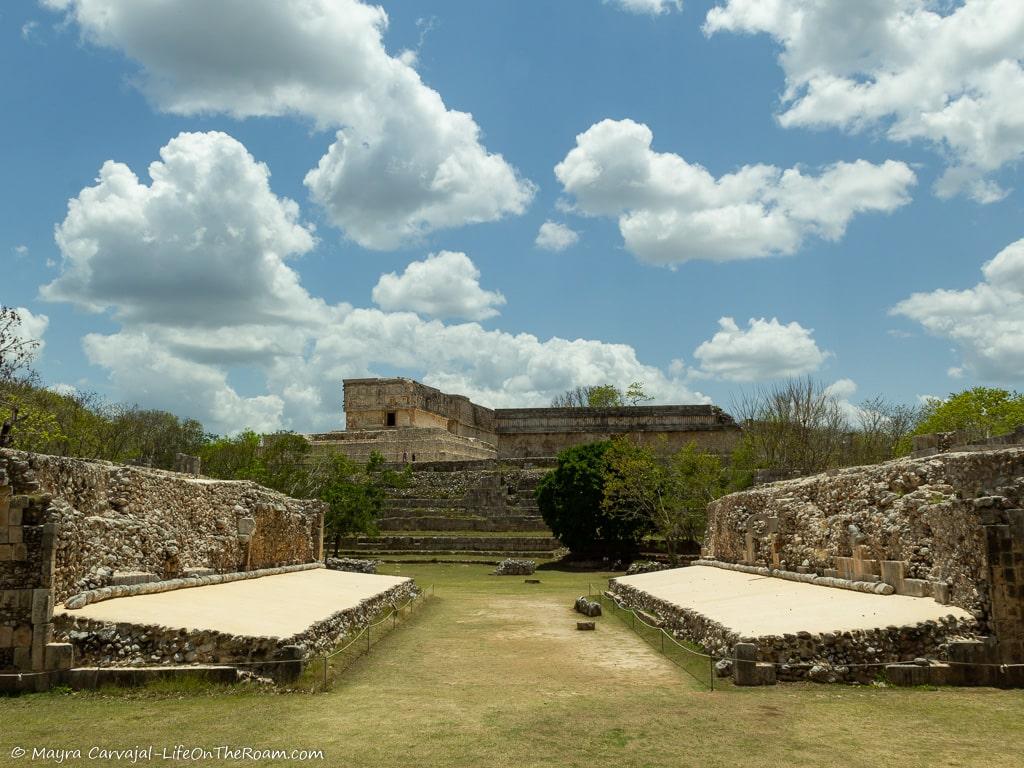
Winning this popular game in the Mayan world was about prestige, human sacrifices, and receiving a nod from the gods. It was a rite.
The (around) 25-cm rubber ball had to be in constant movement and go through the rings placed on the slanted platforms (built around 900 A.D.) and could only be sent there by hitting it with hips, knees, and elbows (there was also something similar to a bat).
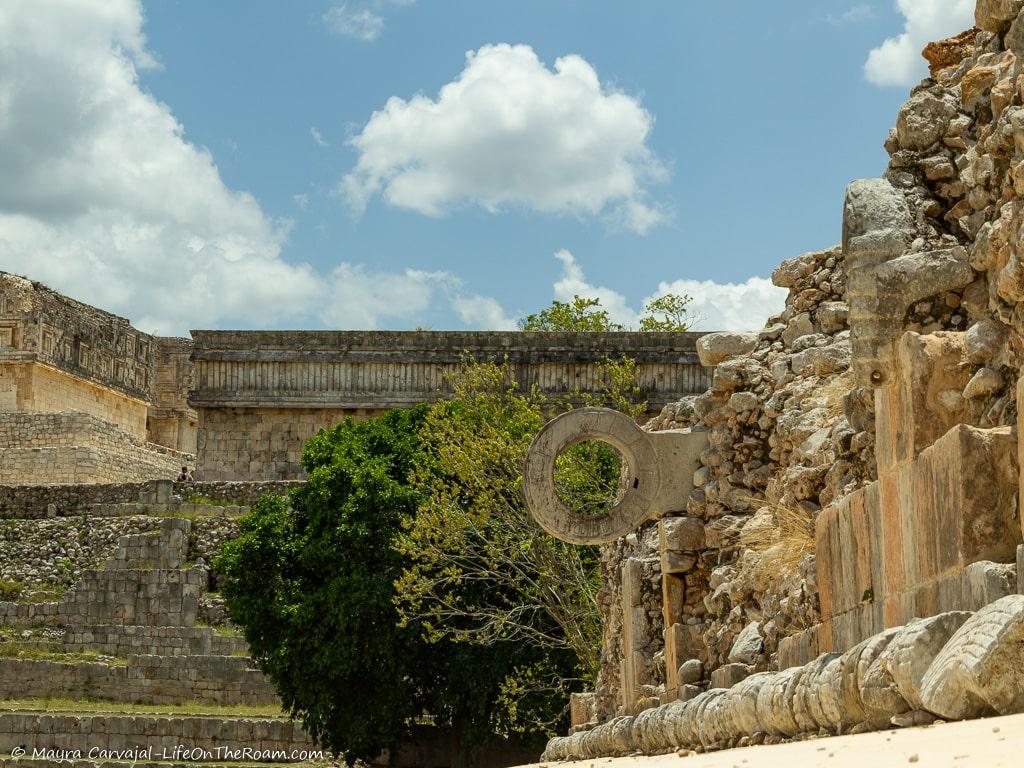
Look Ma, no hands!
The Pigeon Loft Complex (Grupo El Palomar)
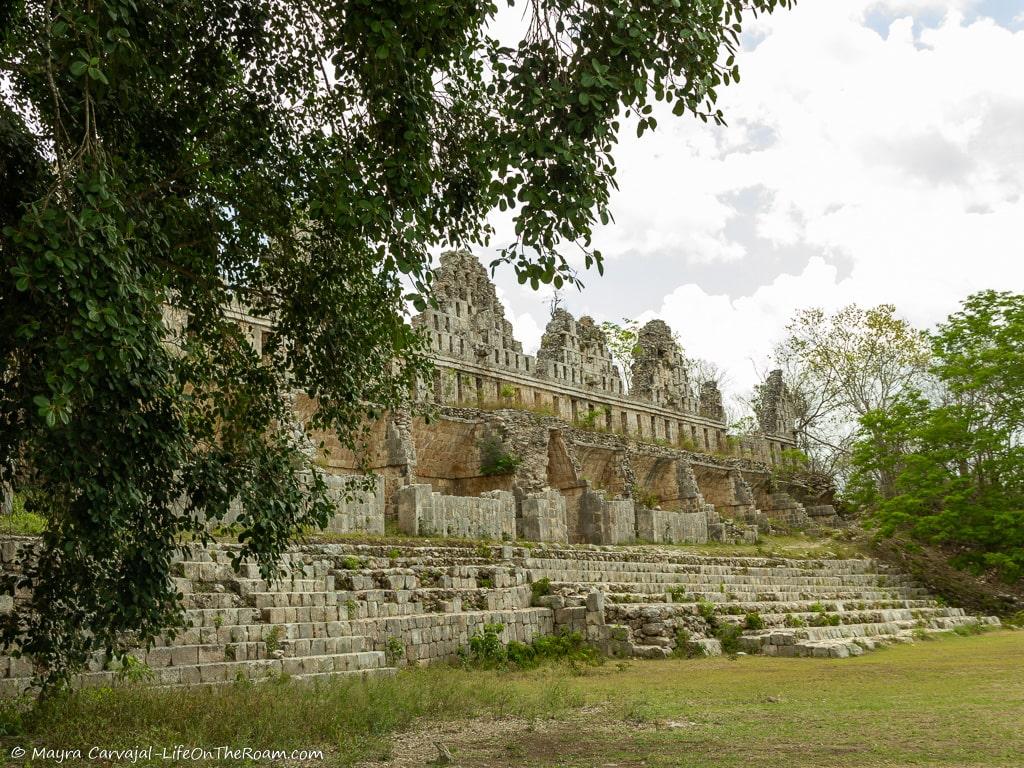
There are three parts to this complex but you can only see the main entrance – known as the House of the Pigeons- featuring curious crest-like triangles with some sort of pigeonholes and centered pedestals.
Another unique detail is the half vault you see under the triangles.
This palace complex was built between the 3rd and 10th centuries and they think it had administrative, ceremonial, and possibly residential uses.
The Great Pyramid (La Gran Pirámide)
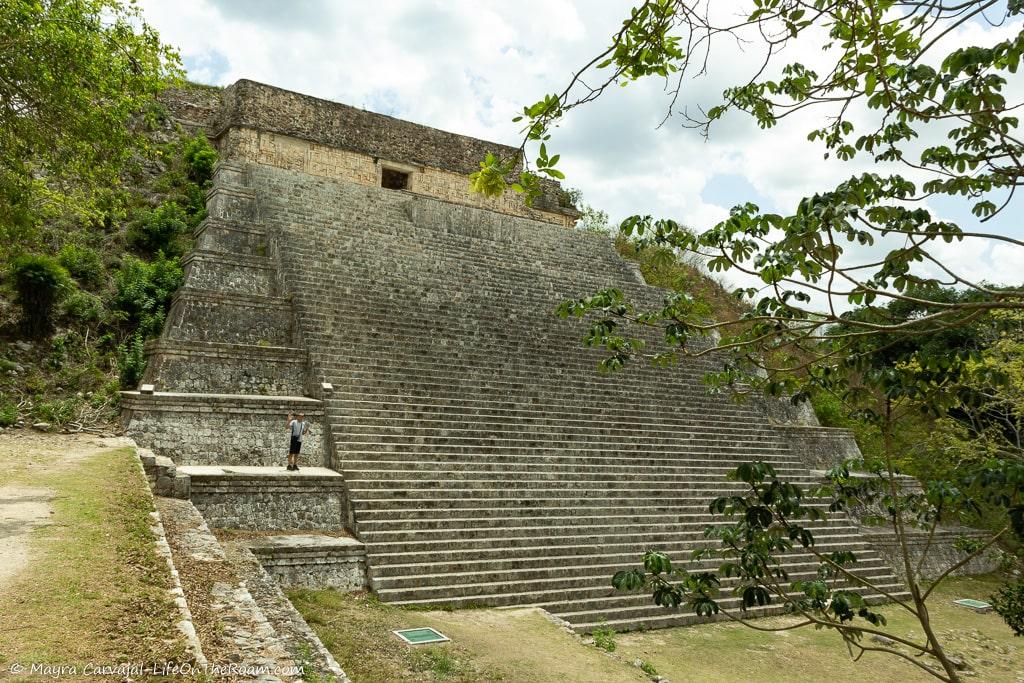
At 30 metres high, it’s almost as tall as the Pyramid of the Magician (five metres short). The nine sections of this structure, built in the mid-eight-century, are crowned with great views of the site and by the Temple of the Macaws (because you see depictions of macaws up there).
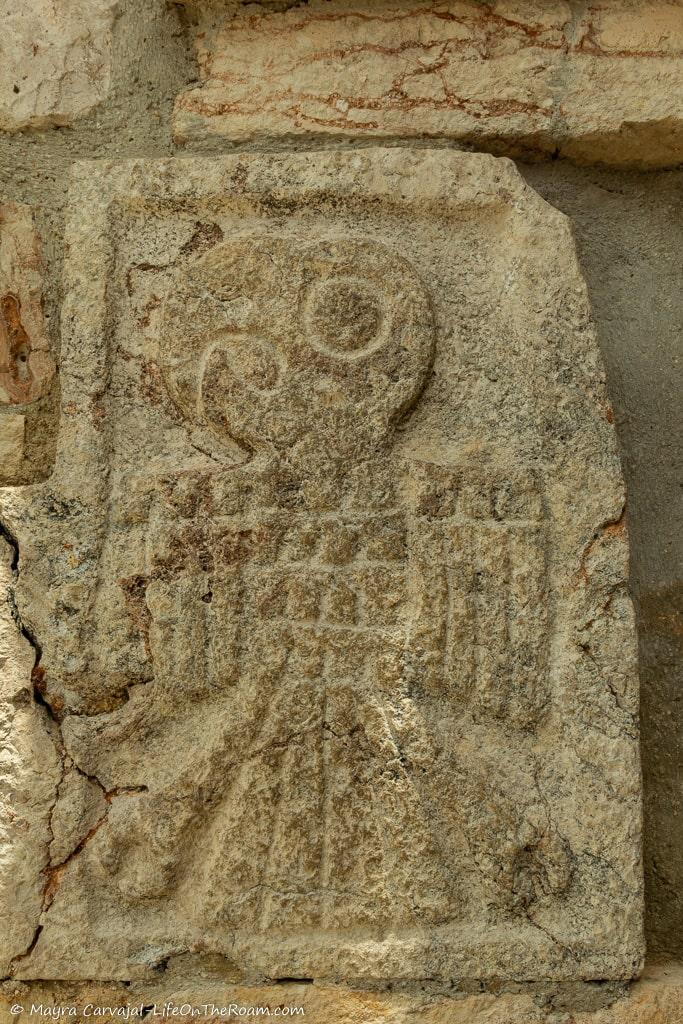
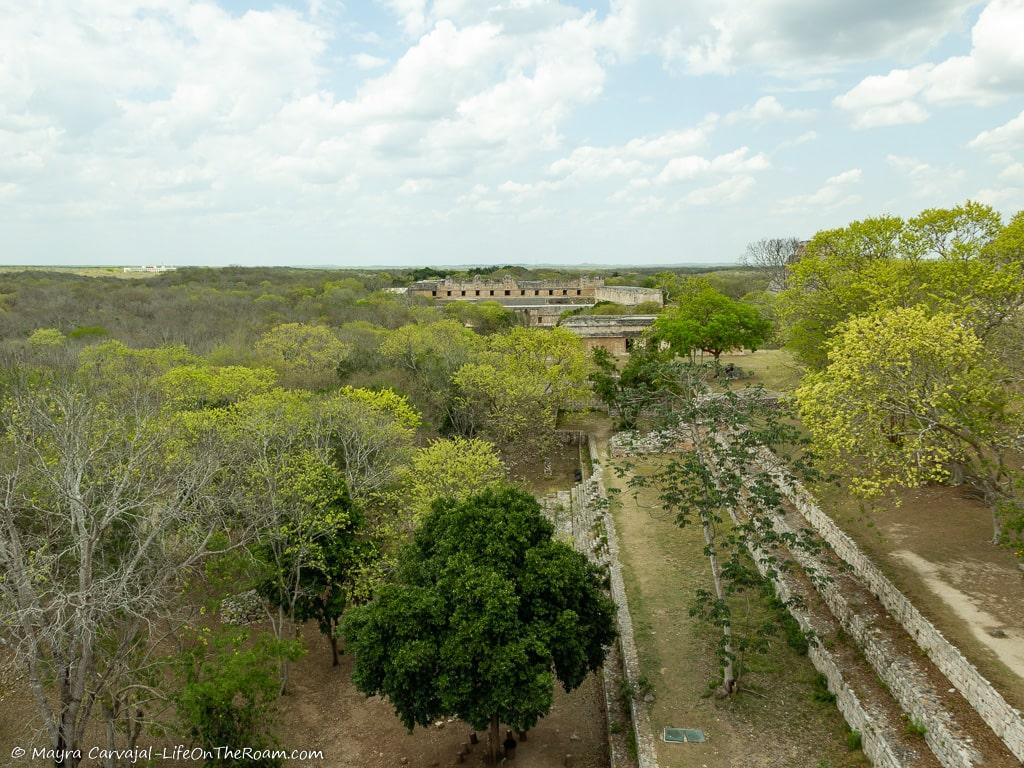
Private tour of Uxmal, Chocolate Museum and Cenote from Merida: after your guided tour to Uxmal with a certified bilingual guide you’ll visit Choco Story to learn about the role of cacao in the Mayan world (with a taste) and end your day with a refreshing splash at Cenote Yaal Utzil.
Book your private tour, with a rating of 4.9/5 based on more than 40 reviews.
The House of the Turtles (La Casa de las Tortugas)
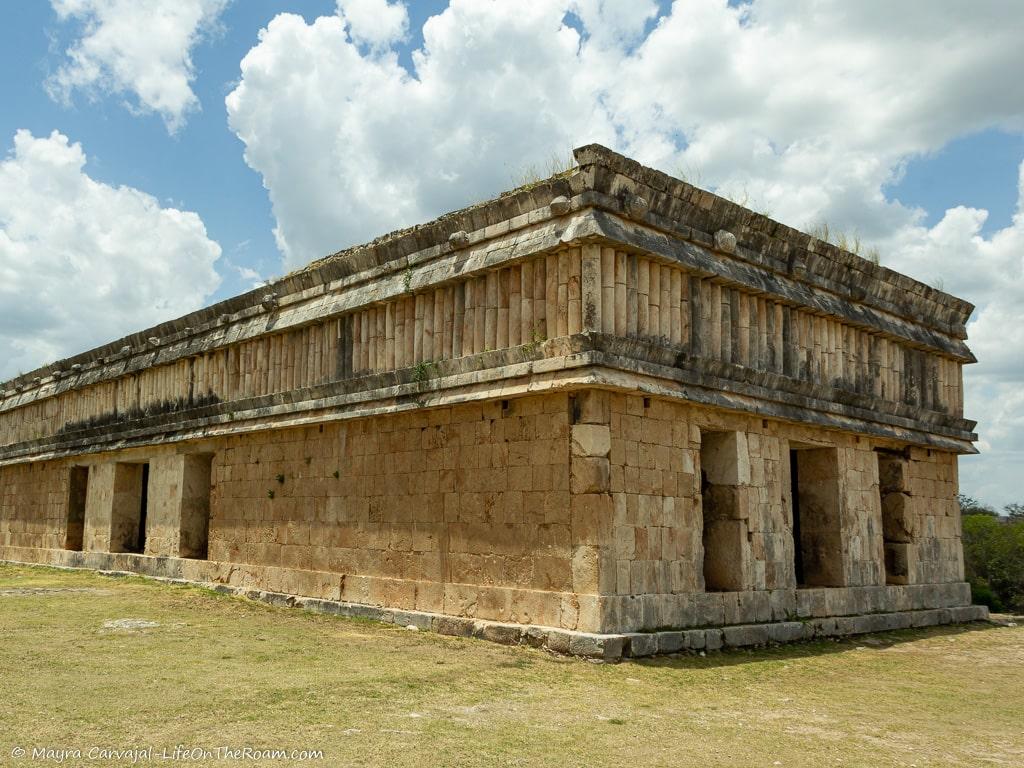
Compared to the massive ornamentation of the other buildings this one is simpler but the colonnade crowning the top, typical of the late Flourishing Puuc style around 900 A.D.-1000 A.D., gives it a stately feeling.
Perhaps it matched the stately conversations people had while sitting or laying down in its rooms.
What about the cute turtles? They think their shells represented the surface of the earth.
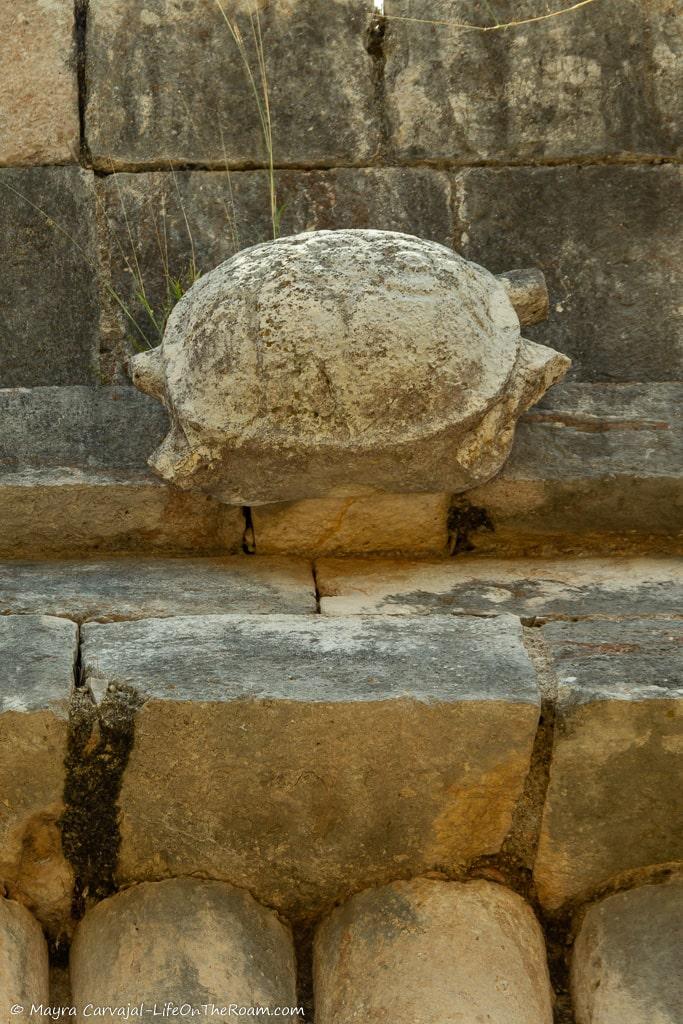
However, turtles were associated with rain, so historians think this was a water-related worshipping temple.
The Governor’s House (La Casa del Gobernador)
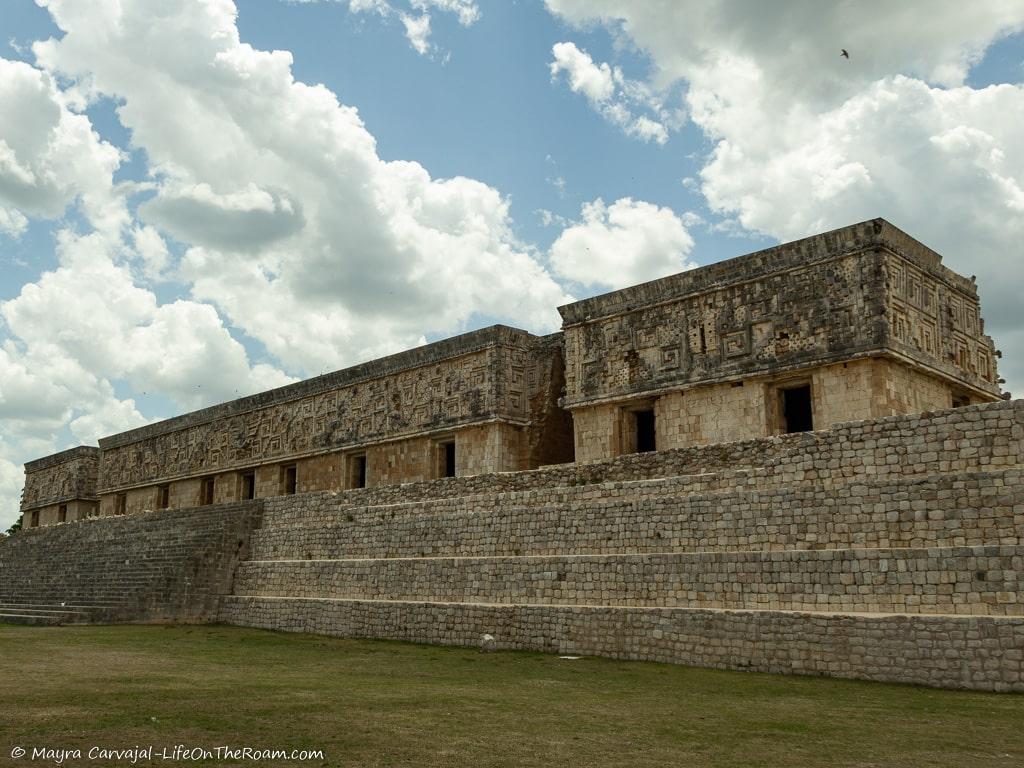
The governor had a great view from his huge, beautifully ornamented palace, divided into three sections by triangular porticos. It was built upon the hill between 900 A.D. and 1000 A.D., where god Chaac kept a watchful eye on everybody from every corner (there are as many as 103 Chaac masks).
Why so many?
Chaac was the god of the rain, and that was the only way they could get water. So they had to keep him happy and count on his mercy.
Experts think the design of the façade refers to the cycle of life and the path of the sun, and it’s dedicated to Venus.
In the centre of the building, the masks share the guard duties with serpents, surrounding the high chief (halach uinic or “Lord Chaac”), who is wearing a crest of feathers.
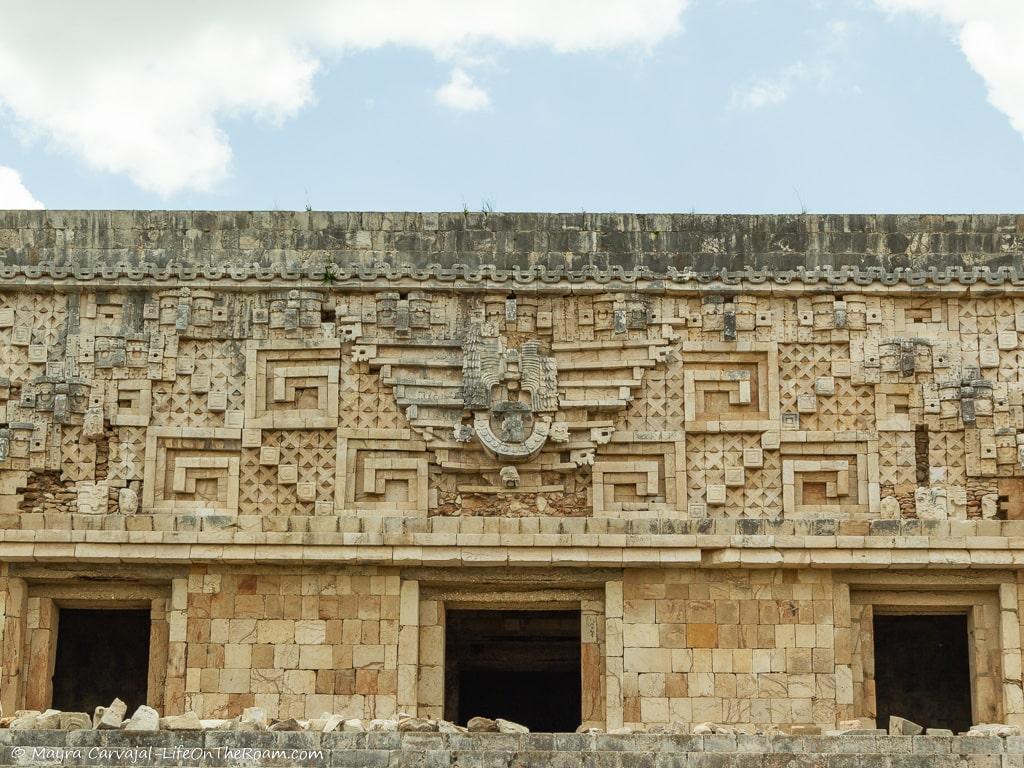
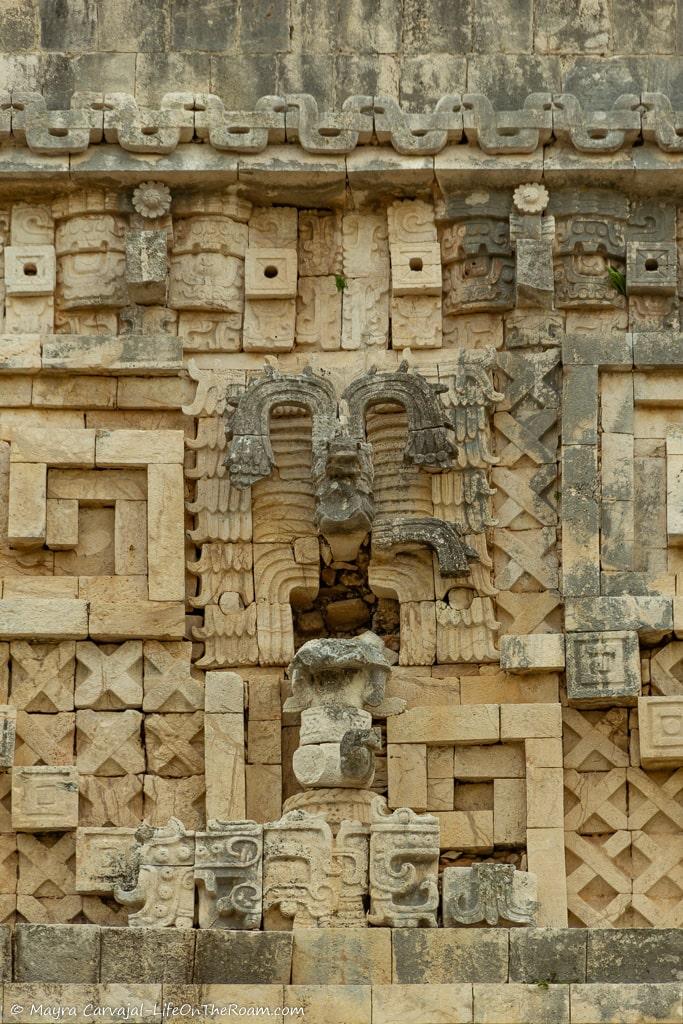
In the adjacent square, there are landmarks such as the pillory shrine and the throne of the jaguar.
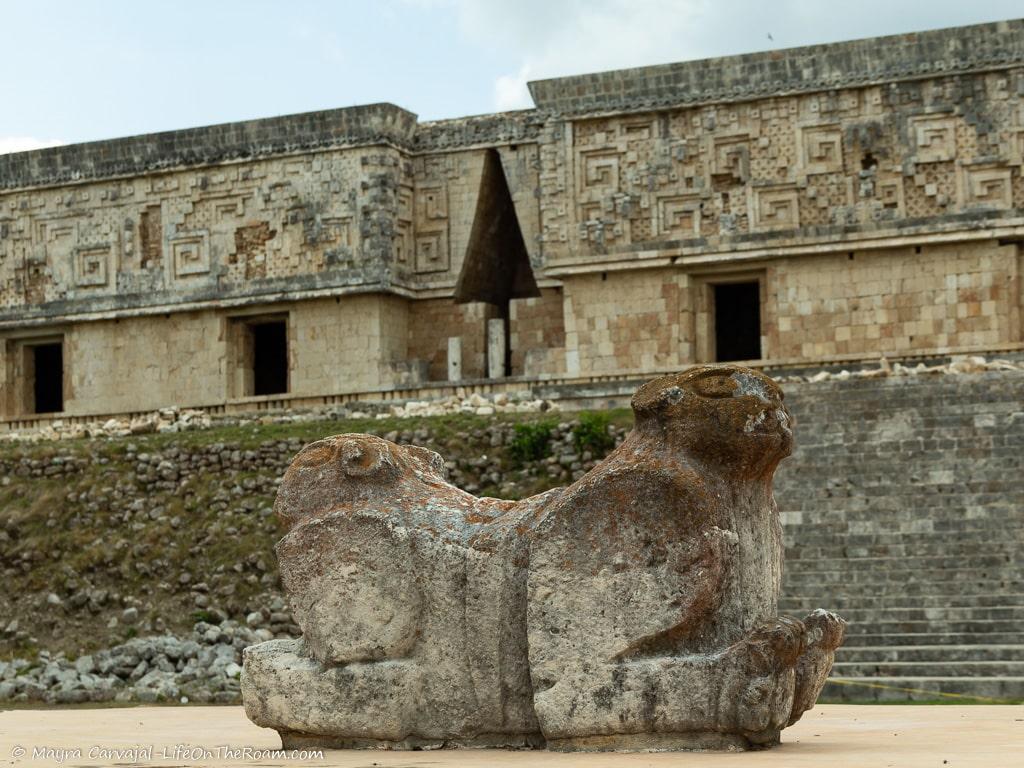
The last one was placed right in front of the main entrance. The big boss would walk in a straight line and sit there to see how big was his kingdom.
Why jaguars? For Mayans, the big cat signifies power and majesty. Something they could never have enough of.
The throne was made of limestone and archaeologists found more than 900 valuable pieces inside: jewellery, weapons, stones, vessels, and other stuff.
The East Portico (El Pórtico del Oriente)
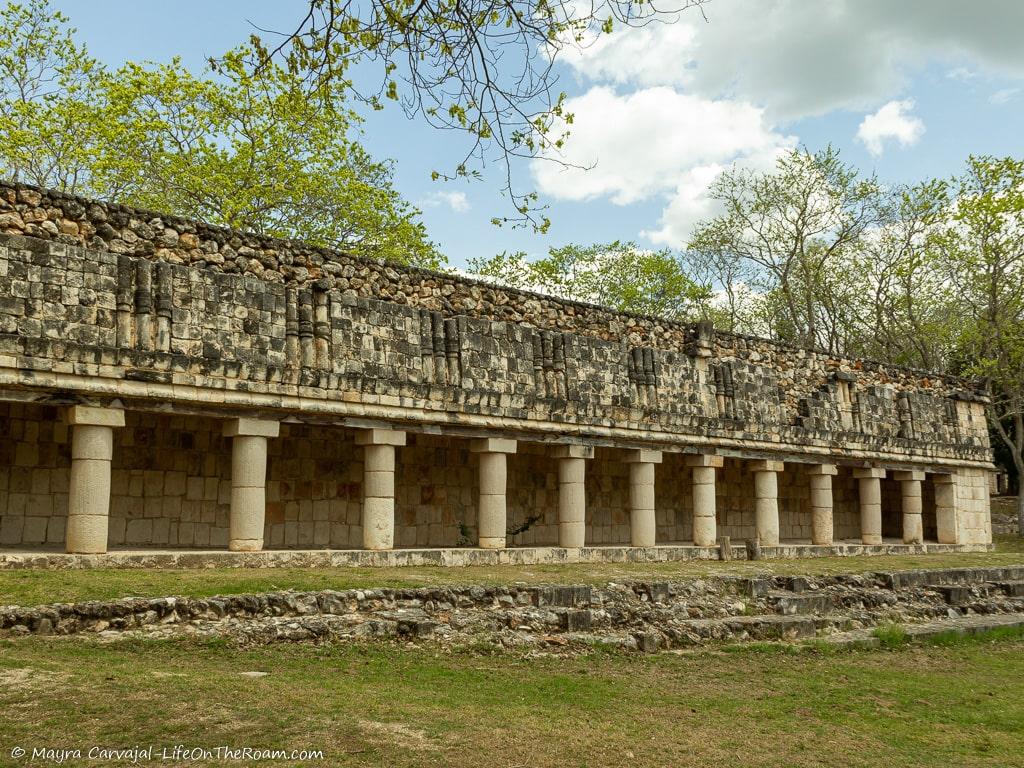
This is another building where you can see colonnades in the upper section frieze.
Archaeologists believe that, due to its proximity to the ball game court, this was what we call today the locker room. The players would not only put on the knee and elbow pads but would also conduct purification and spiritual ceremonies.
Uxmal Archeological Site
Km. 78 Highway 261 (Merida-Campeche), Yucatán; Open every day: 8AM-4PM. General admission: MXN$556. This covers the entrance fee and the “government” fee.
5-Day Mayan Heritage History Tour: this guided small-group tour stops at several sites, including Uxmal, Tulum and Chichen Itza to learn about Mayan history and culture. Departs from Cancun or Playa del Carmen and includes accommodation and admission fees.
Book your Mayan adventure, with a rating of 4.9/5 based on more than 25 reviews.
Other Things to Do in Uxmal
Visit Choco-Story (Eco Park Chocolate Museum)
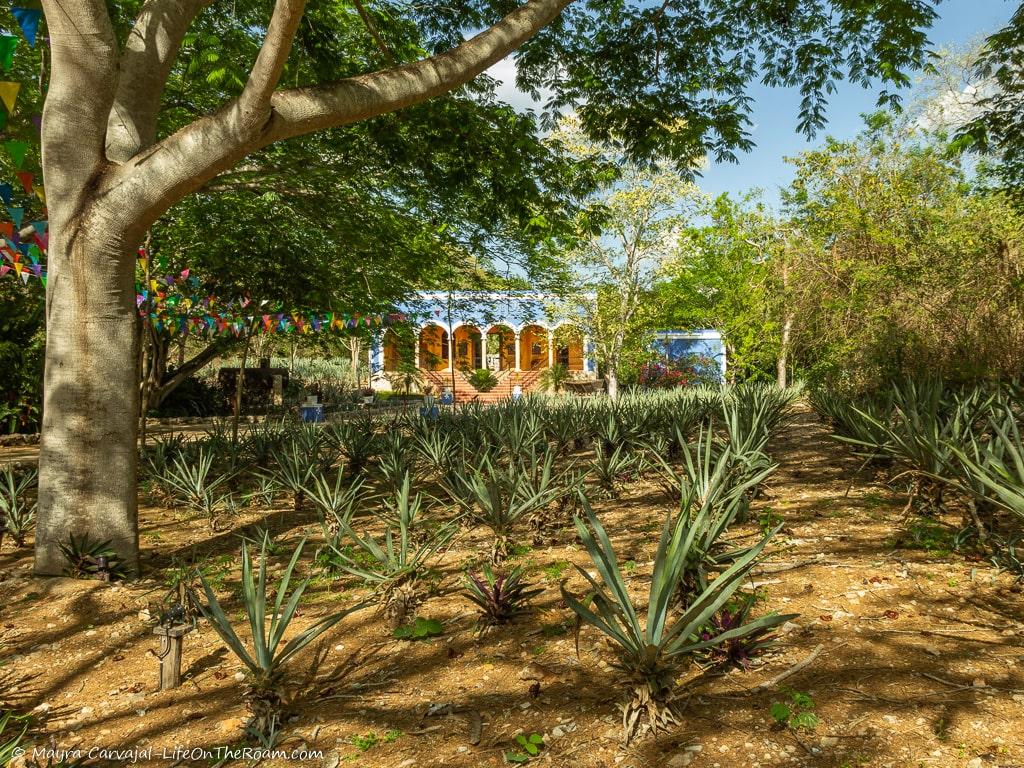
Choco-Story is a combination of a museum, an animal sanctuary, and a botanical garden on the grounds of a 17th-century hacienda that became a sugar mill in the 18th century.
The site is only 500 metres from the entrance to Uxmal, across the street.
You’ll learn about the fascinating history of the cacao, its varieties, the machinery used in its production, and some interesting statistics regarding the production and consumption of chocolate around the world (did you know that people in Switzerland and Belgium eat more chocolate than anywhere else in the world?).
An Animal Sanctuary
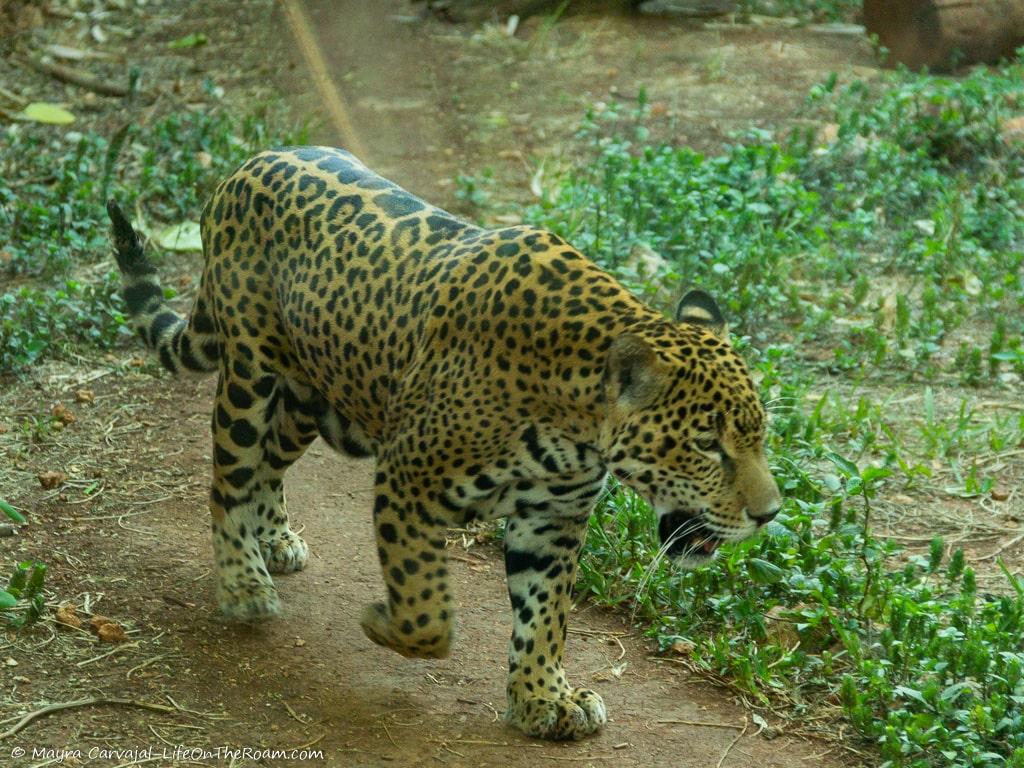
This is not a zoo! You’ll see wild animals that ended up here because they were taken out of their natural environment as babies to be sold illegally as pets.
In most cases, after the wild nature of the animal started to develop the owners couldn’t handle them and at that point, they can’t be released into the jungle because they wouldn’t survive.
Some of them have been hurt by hunters (like the jaguar). So here they are.
You’ll see spider monkeys and white-tailed deer, and you’ll even have the chance to feed them.
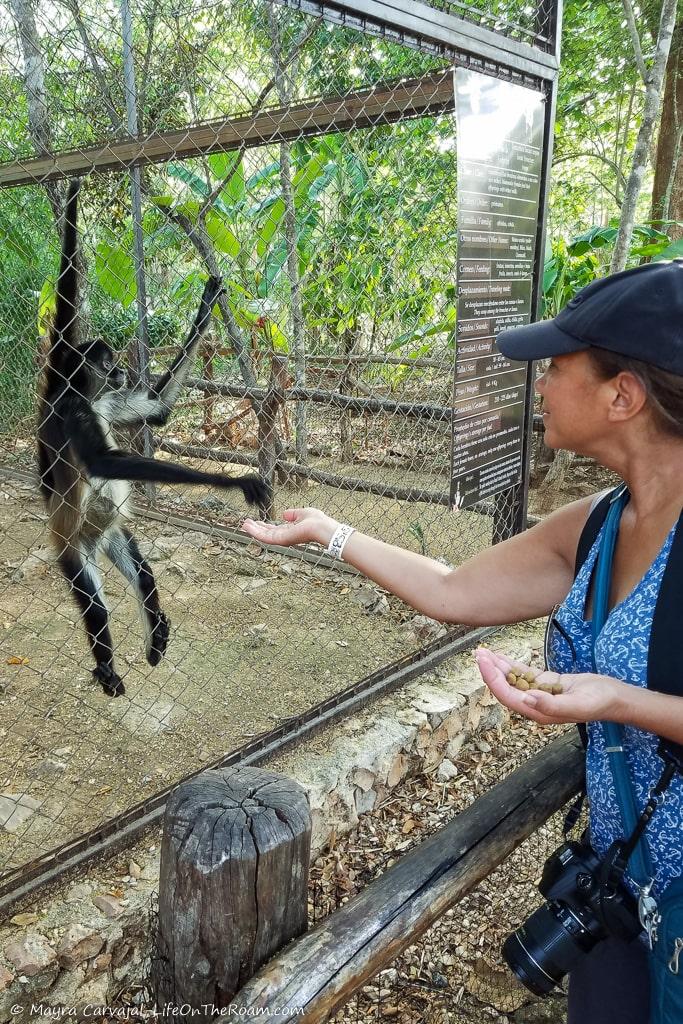
There are also crocodiles and an apiary.
A Botanical Garden

As you walk from hut to hut to learn about chocolate you’ll see gardens with endemic plants and native trees. The educational signs will teach you how the locals used them for different purposes.
And the flowers are so pretty!
Learn About the History of Cacao: From the Mayans to Arrival in Europe
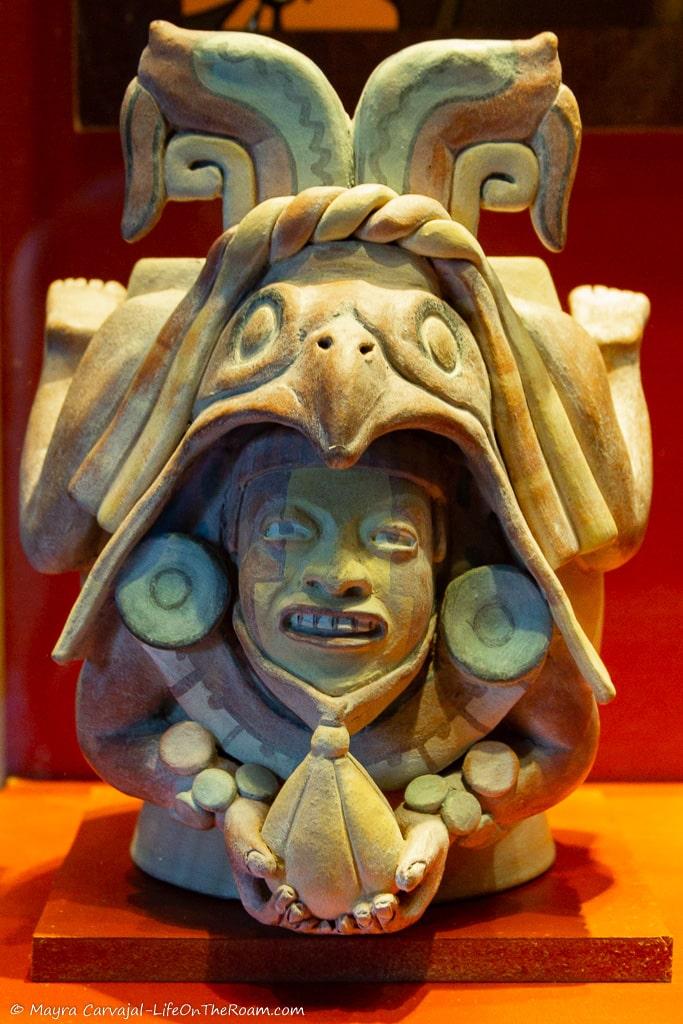
Did you know that the word cacao comes from the Olmec word Kakaw?
What the Mayans drank was quite different from the sugary drink you enjoy today. They roasted, peeled, and ground the cacao beans, and mixed the paste with water and spices.
It wasn’t sweet, it was spicy.
It was also a sacred drink (if you ask me it still is, doesn’t it taste like a gift from heaven?).
They whisked it to make it frothy and offered the foam to the gods. The upper class drank it in ceramic cups adorned with jewels and paintings while the rest (not everyone could afford it) did it from empty gourds.
Chocolate was a drink commonly used in ceremonies on this side of the planet as far as 2,000 B.C. (you can see a recreation of a Chac Chaac ceremony during your visit).
A drink with a twist, though.
People would have several cups of cacao before walking into a human sacrifice (their blood and their heart would be offered to the sun and the gods to strengthen them in their battles against monsters of the underworld).
The drink was an offering to the gods, but they added a special touch.
With the help of a sharp object (a cactus thorn, the spine of a ray, or a knife made of stone) they would pierce their tongue or their earlobe and spill the blood over the cacao beans before preparing it. Ew!
Cacao was like the champagne of that time in the Mayan world. Getting married? Toast with cacao. Turning 40? Cheers with cacao. Had a baby? Same. Your brother passed away? Wash his body with water and then use the same water to prepare your chocolate. Ewww!
In the exhibit, you’ll see stelas, pottery, and codex (books) copies, with scenes of ceremonies where cacao pods are being offered to the gods.
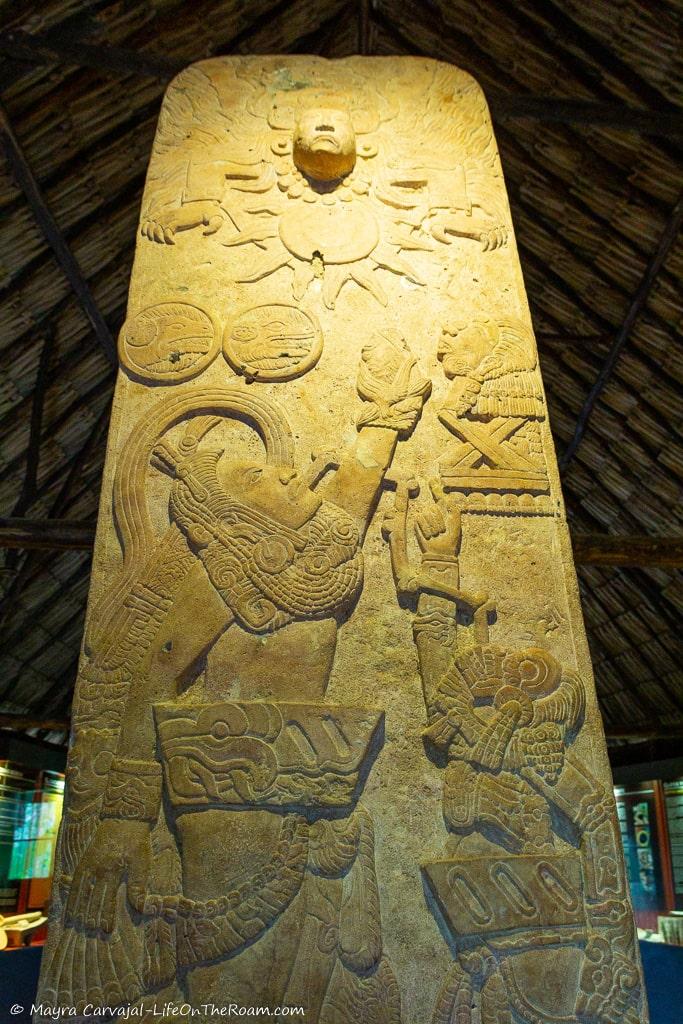
There are also objects and tools used by the Mayans during the process.
Did you know that cacao beans were also used as currency?
While you visit the reproduction of a Mayan House and learn about the construction methods and funerary rites you can enjoy a cup of chocolate and mix the spices to satisfy your taste.
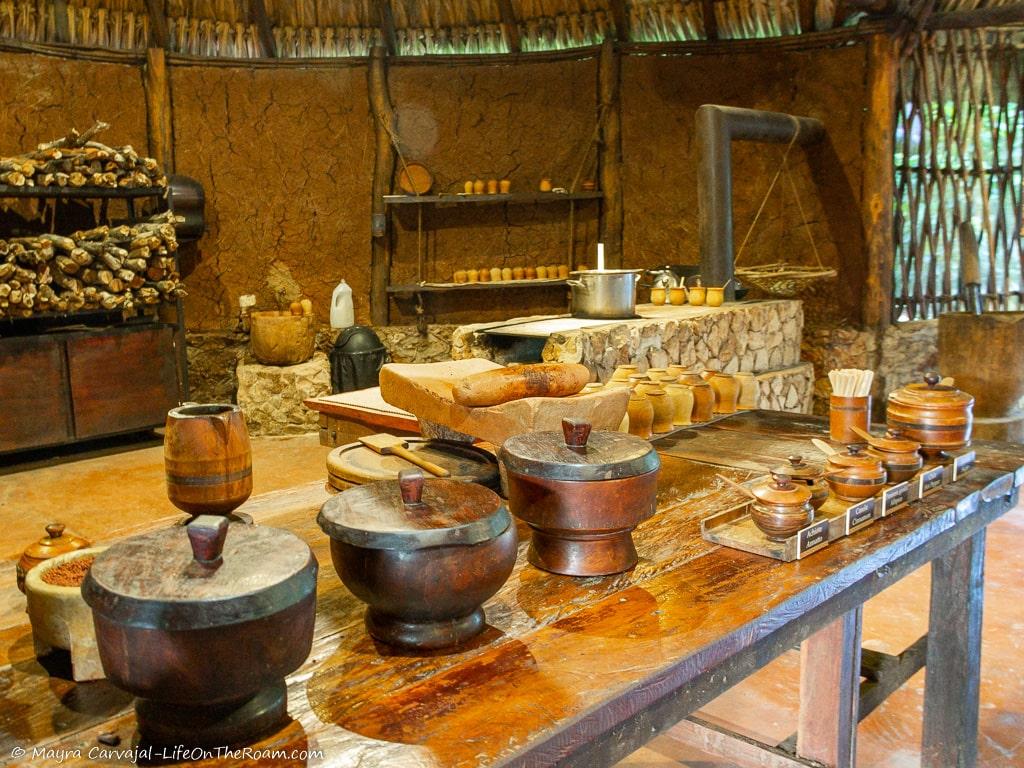
Will you go all Mayan, and add loads of hot pepper and allspice and no sugar? Or will you tame it and pour some sugar and maybe some annatto and cinnamon? When Spaniards drank their first chocolate they weren’t happy.
Ew! What’s this? It was spicy. But then they started adding more sugar and fewer spices.
Hmmm…we may have something here. They took it to Europe and the rest is history. But up till the end of the 18th century, only the rich and famous could afford it.
People were eager to try the mysterious beverage from the other side of the world and they slowly transformed the way to drink and consume chocolate worldwide. A whole side industry developed out of this when manufacturers created fine china and silverware to serve and store it.
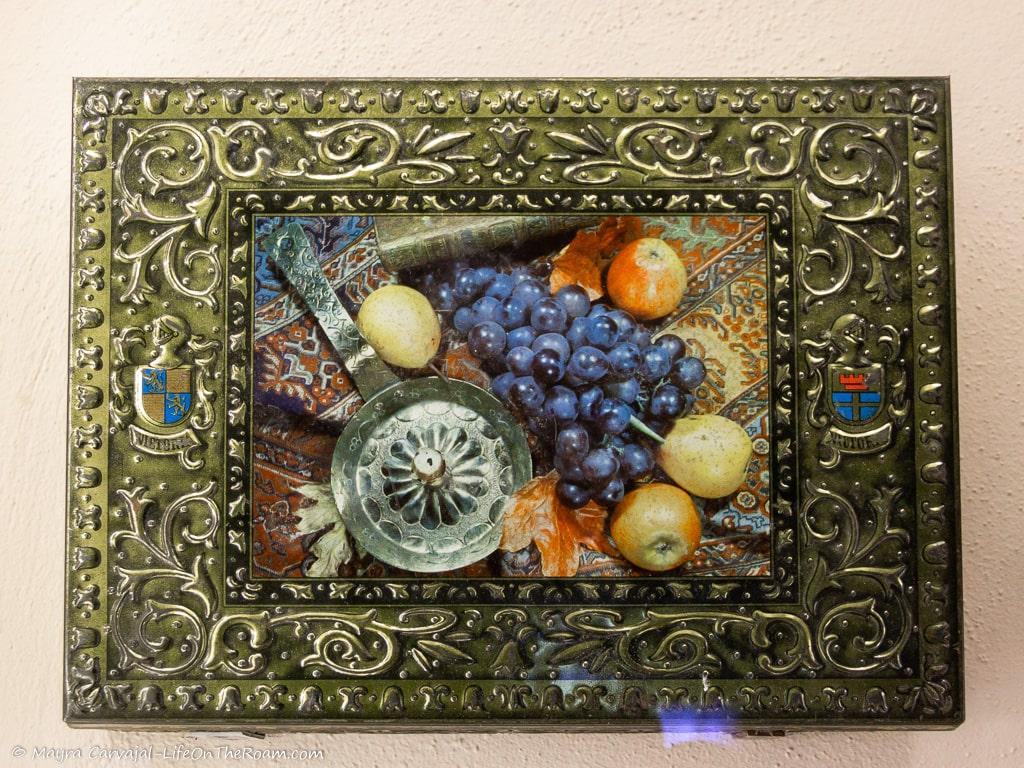
It wasn’t until 1840 that chocolate was produced in a solid form and poured into moulds. Machinery allowed mass production bringing the price down and now the commoner can also enjoy this delicious product.
Get Your Chocolate Fix
You can visit their store to get some chocolate that, according to them, follows the early recipe used by Spaniards in the 1650s, and try some bars made with cacao from different countries.
You can even make your own chocolate by signing up for their workshops for kids and adults.
There are products such as chocolate shampoo, hand soap, and spices for sale.
Choco-storymexico.com
Km. 78 Highway 261 (Merida-Campeche), Yucatán (across Uxmal ruins entrance); Open every day: 9AM-7:30PM (closed on Christmas Day and New Year’s Day). General Admission: MXN$ 210.00; Save at least 1.5 hours to visit this attraction
Explore Other Archeological Sites of the Puuc Route
Within less than 30 minutes you can reach the other archeological sites that are part of the Puuc Route (Ruta Puuc): Kabah, Sayil, Xlapak, Labná, and the Loltun Grottoes. They may not be as famous and magnificent as Uxmal, but if you loved the architectural style there, you’ll love it here too.
I visited them all (except Loltun) on a day road trip after being to Uxmal. It may seem too much, but I love this stuff. If you’re not that into it you may end up “ruined” out.
Take a Plunge in the Cenotes
You can include in your trip a visit to several cenotes (sinkholes filled with underground water). The most famous are Kankirixche and Mucuyché.
Full disclosure: I haven’t visited these cenotes, but I wanted to mention them so you know it’s something you can do while you’re in the area.
Where to Stay in Uxmal
The Lodge at Uxmal: I stayed here when I first came to Uxmal. The best thing? Its location, right across the site. You’ll be right there when it opens and you’ll have the place all for yourself. Big rooms, beautiful gardens and a nice restaurant with nice margaritas.
Book your room at The Lodge, with a rating of 8.1 based on more than 315 reviews.
Uxmal Resort Maya: I stayed here during my second visit to Uxmal. It’s still close to the site (less than 2 kms) and with views of a nice garden with many birds. Not as nice as the Lodge at Uxmal, but it’s a cheaper alternative within the area.
Stay at Uxmal Resort, with a rating of 7.8 based on more than 1,370 reviews.
Hotels in Merida: you can also stay in the city of Merida and rent a car to drive to the site, or take the bus from the TAME bus station (Terminal de Autobuses de Mérida), located between streets 68, 69, and 70. The trip takes around 1.5 hours.
All the details I gushed about make Uxmal my favourite Mayan archaeological site in Mexico. I’ve been there twice, and I wouldn’t mind visiting a third time. It may become your favourite Mayan site too.
RELATED POSTS
BOOKING FLIGHTS AND ACCOMMODATIONS
Book your flight without losing your shirt
We check Momondo to find great deals to book our flights. Also, check Great Escape: it combines the listings from Expedia, Kiwi, Kayak, (and Skyscanner on the premium service) to find the best airfares.
To find a place to stay for less
Booking.com: this site combines everything under the sun. You’ll find hotels, apartments, B&B, hostels, rooms, etc., with all sort of filters to make your search a breeze.
Hotwire: the first site I check when we plan to stay at a hotel for a few nights. You can save anything from 20% to 60%. Use the search filter to find what you want and you’ll end up with three listings that match your criteria. You’ll know which one you’ll get after you book. If you can handle a little bit of uncertainty you can score big savings.
House Sitting: you take care of people’s pets and house for free while staying for free. It’s the closest thing to experiencing a place “like a local”. But it comes with responsibilities… Are you an animal lover? It may become your new way to travel.
To get travel insurance
SafetyWing: travel medical insurance that gives us peace of mind knowing that we’re covered in case of emergency. It’s convenient, affordable, and suitable for digital nomads who spend a long time outside their home country.
Check the full list of travel resources on my Resource Page for more options and savings
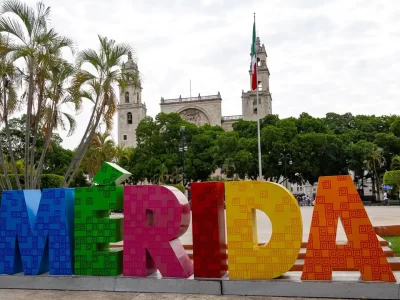
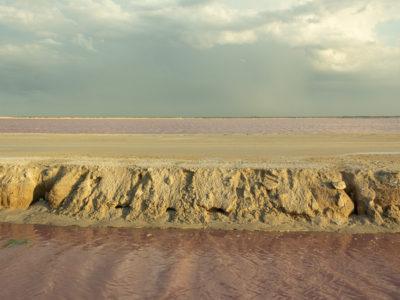
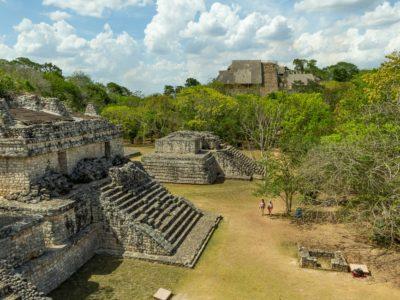
Awesome places, a few of these are on my list, and would love to travel and check them. Thank you for sharing!
Thanks for reading!
Mexico is a very rich culture. It is fascinating to read about it but it is much better to have the opportunity to experience it. Thank you for bringing so many beautiful places like Uxmal to our attention.
Spot on! Very rich culture indeed.
The ruins are something else… the scale of them is mind blowing and yet the smaller scale detail is so intricate. Beautiful.
The intricate details got me at hello!
Omg, this was one of the most interesting posts that I have read in a while! Mayan ruins are fascinating and I dream about going there and seeing with my eyes at least a part of that all. My second biggest dream is to visit Machu Picchu. Have you ever been there or maybe you are planning to go there?
I really enjoyed your post! You have many beautiful photos and short but very interesting facts and stories. Thank for that!
Thanks for reading! I haven’t been to Machu Picchu yet, but it’s high up there in the bucket list. Not sure yet if I’ll get thereby doing the Inca Trail, or taking the train. LOL.
Despite the fact that Uxmal is far from Cancun, it’s worth coming there and I’m glad I did.
Absolutely! Glad you enjoyed this fabulous site.